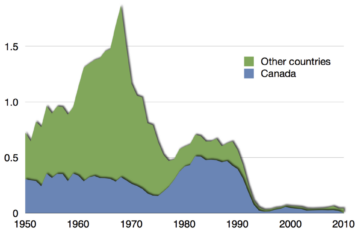by David Greer

A group of island neighbours were enjoying a glass of wine in the old wooden boathouse when our quiet conversation was interrupted by an explosive Whupf! from the direction of the sea. We turned to look just in time to see the black-and-white hulk of a six-ton orca, curving gracefully into the water after a deep breath, its six-foot-high dorsal fin marking it as a mature male.
Where there is one orca, others are sure to follow. Loud blasts of spray echoed through the evening air as other members of the pod appeared, mothers with calves, juvenile males, a couple more large mature males. Some close to shore, others a half a mile out at sea. The whales’ appearance hadn’t been a complete surprise, one of our group having received a text alert from a fellow sighter in the Southern Gulf Islands Whale Sighting Network that the orcas had been seen heading west from Saturna Island towards our vantage point by Brooks Point on South Pender Island, the southernmost of the Canadian Gulf Islands, in the heart of the Salish Sea and smack in the middle of southern resident orca critical habitat.
As suddenly as they had arrived, the orcas were gone, continuing west towards Vancouver Island. Then, moments later, a much louder explosion of breath took us by surprise. This we were not expecting. Gazing seaward again, we watched as a far larger black body edged silently above the surface, like a nascent island arising from a seafloor volcano, a high cloud of fine mist dissipating above its pair of blowholes (orcas have only one). The adult humpback, forty tons give or take, perhaps more easily imagined as the size of a school bus, had passed less than a hundred metres from the point, heading northeast. Unlike the orcas, the humpback travelled alone, and there was no apparent interaction between the two species. To watch both in the space of ten minutes at relatively close range left us awestruck. Leviathan tends to have that impression on puny human observers.
Humpbacks and Orcas–Gentle Giants and Dolphins with Attitude
The contrasts between orcas and humpbacks are striking. Both are cetaceans, the animal group whose name derives from the ancient Greek word for sea monster. Cetaceans comprise two groups: whales with teeth (toothed whales) and whales without (baleen whales, including the humpback). Toothed whales include narwhals, belugas, sperm whales, beaked whales, porpoises, and dolphins. All dolphins are whales but not all whales are dolphins. The largest of the dolphins is the orca (Orcinus orca), commonly known as the killer whale, an apt descriptor for a meticulous and cunning predator with very specific tastes: chinook salmon for southern resident orcas, marine mammals for transit orcas otherwise known as Biggs orcas. Orca pods have been known to attack humpbacks on occasion, but generally only when an adult is accompanied by a juvenile, a potential meal for mammal-eating orcas. Read more »


 In an age where there is little agreement about anything, there is one assertion almost everyone agrees with—there is no disputing taste. If someone likes simple food instead of complex concoctions, who is to say that’s wrong. If I prefer bodice rippers to 19th Century Russian novels, you might say my tastes are crude and uncultured but hesitate to say one type of literary work is inherently better than the other. Aesthetic judgments are about subjective preference only. This is especially true of food and drink. Our preferences in this domain seem especially subjective. You can’t be wrong if you dislike chocolate ice cream can you?
In an age where there is little agreement about anything, there is one assertion almost everyone agrees with—there is no disputing taste. If someone likes simple food instead of complex concoctions, who is to say that’s wrong. If I prefer bodice rippers to 19th Century Russian novels, you might say my tastes are crude and uncultured but hesitate to say one type of literary work is inherently better than the other. Aesthetic judgments are about subjective preference only. This is especially true of food and drink. Our preferences in this domain seem especially subjective. You can’t be wrong if you dislike chocolate ice cream can you?


 How do we regulate a revolutionary new technology with great potential for harm and good? A 380-year-old polemic provides guidance.
How do we regulate a revolutionary new technology with great potential for harm and good? A 380-year-old polemic provides guidance. Firelei Báez. Sans-Souci, (This threshold between a dematerialized and a historicized body), 2015.
Firelei Báez. Sans-Souci, (This threshold between a dematerialized and a historicized body), 2015.


 I take the row covers off of two forty-foot rows of beans (three varieties) as the plants have become so big so fast in the ungodly heat they are pressing against the cloth. Afterwards, in the early evening, I let the chickens out of their sweltering little house to run free for a couple of hours. I will watch them to see if they bother the plants. The birds might peck at and scratch up the bean plants, but these plants are so large the birds should be indifferent to them. The experiment is a success: The plants bask in full sunlight while the birds rummage for grubs around them. I decide to leave the row covers off for now and will recover them at night to deter the deer. One’s smallness is manifested in gardening, as the gardener is a single organism set against myriads. It is wise to tend to one’s insignificance during these times. Come what may, no one will care much about those who stay at home husbanding rows of Maxibel haricots.
I take the row covers off of two forty-foot rows of beans (three varieties) as the plants have become so big so fast in the ungodly heat they are pressing against the cloth. Afterwards, in the early evening, I let the chickens out of their sweltering little house to run free for a couple of hours. I will watch them to see if they bother the plants. The birds might peck at and scratch up the bean plants, but these plants are so large the birds should be indifferent to them. The experiment is a success: The plants bask in full sunlight while the birds rummage for grubs around them. I decide to leave the row covers off for now and will recover them at night to deter the deer. One’s smallness is manifested in gardening, as the gardener is a single organism set against myriads. It is wise to tend to one’s insignificance during these times. Come what may, no one will care much about those who stay at home husbanding rows of Maxibel haricots.

 This week marks one year since Affirmative Action was repealed by the Supreme Court. The landmark ruling was a watershed moment in how we think of race and social mobility in the United States. But for high schoolers, the crux of the case lies somewhere else entirely.
This week marks one year since Affirmative Action was repealed by the Supreme Court. The landmark ruling was a watershed moment in how we think of race and social mobility in the United States. But for high schoolers, the crux of the case lies somewhere else entirely.